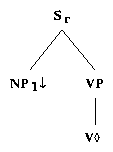



Next: Sentential Subjects and Sentential
Up: Verb Classes
Previous: Idiom with V, D,
Ergatives
Verbs in English that we will callergative 7.1 display the kind of
alternation shown in the sentences in ((7)) and ((8)) below.
(6)0(6
- (7)
- The sun melted the ice .
(7)0(7
- (8)
- The ice melted .
The object of the transitive sentence in ((7)) corresponds to the subject
of the intransitive sentence in ((8)). The literature discussing such pairs
is based largely on syntactic models that involve movement, particularly GB.
Within that framework two basic approaches are discussed:
- Derived Intransitive
The intransitive member of the
ergative pair is derived through processes of movement and deletion from an
underlying transitive structure [#!Burzio86!#,#!HaleKeyser86!#,#!HaleKeyser87!#].
- Pure Intransitive
The intransitive member is intransitive at all levels of the
syntax and the lexicon and is not related to the transitive member
syntactically or lexically [#!Napoli88!#].
Although XTAG does not have derivational movement, the relationships between
the two arguments can be translated to the FB-LTAG framework. In the XTAG
grammar the difference between these two approaches is not a matter of movement
but rather a question of tree family selection. The relation between sentences
represented in terms of movement in other frameworks is represented in XTAG by
membership in the same tree family or selection of multiple families which
preserve the argument relations across families. Wh-questions and their
indicative counterparts are one example of the former, whereas ergatives and
ditransitives with PP shift exemplify the latter. Adopting the Pure
Intransitive approach suggested by
[#!Napoli88!#] would mean placing the intransitive ergatives in a
tree family with other intransitive verbs and separate from the
transitive variants of the same verbs. This would result in a grammar
that represented intransitive ergatives as more closely related to
other intransitives than to their transitive counterparts. The only
hint of the relation between the intransitive ergatives and the
transitive ergatives would be that ergative verbs would select both
tree families. While this is a workable solution, it is an
unattractive one for the English XTAG grammar because semantic
coherence is lost. In particular, constancy in thematic role is
represented by constancy in node names across sentence types within a
tree family. For example, if the object of a declarative tree is
NP1 the subject of the passive tree(s) in that family will also
be NP1.
The analysis that has been implemented in the English XTAG grammar is
an adaptation of the Derived Intransitive approach. The ergatives
select the two families Tnx0Vnx1 and TEnx1V. TEnx1V is quite similar
to the regular intransitive family Tnx0V, except that it encodes a
different type of semantic function--the syntactic subject of TEnx1V
is given the index of `1' to represent that it is the logical object
of the verb. The two families Tnx0Vnx1 and TEnx1V create the two
possibilities needed to account for the data.
- intransitive ergative/transitive alternation. These verbs
have transitive and intransitive variants as shown in sentences ((9)) and
((10)).
(8)0(8
- (9)
- The sun melted the ice .
(9)0(9
- (10)
- The ice melted .
In the English XTAG grammar, verbs with this behavior select family
{Tnx0Vnx1
TEnx1V}. The first family in the union handles
sentences such as ((9)) and the second covers ((10)).
- transitive only. Verbs of this type do not allow the
intransitive ergative variants, as can be seen in the pattern shown in
sentences ((11)) and ((12)).
(10)0(10
- (11)
- Elmo borrowed a book .
(11)0(11
- (12)
- A book borrowed .
Such verbs select only the family Tnx0Vnx1, and thus do not have the
ergative trees in TEnx1V available to them.

- {Ergative Tree: $\alpha$Enx1V
The declarative ergative tree is shown in Figure 7.1.
Note that the index of the subject NP indicates that it originated as
the object of the verb.




Next: Sentential Subjects and Sentential
Up: Verb Classes
Previous: Idiom with V, D,
XTAG Project
http://www.cis.upenn.edu/~xtag

